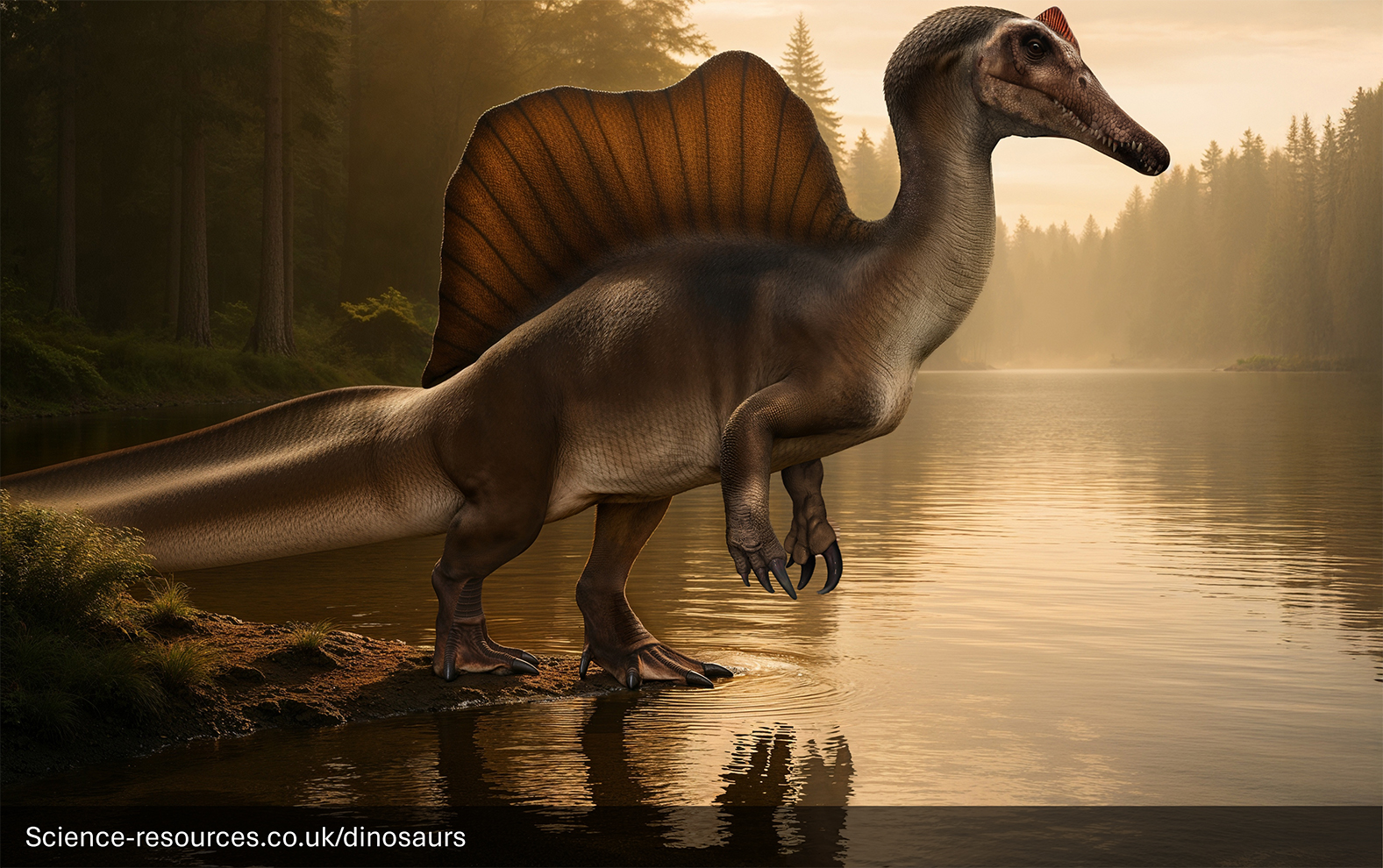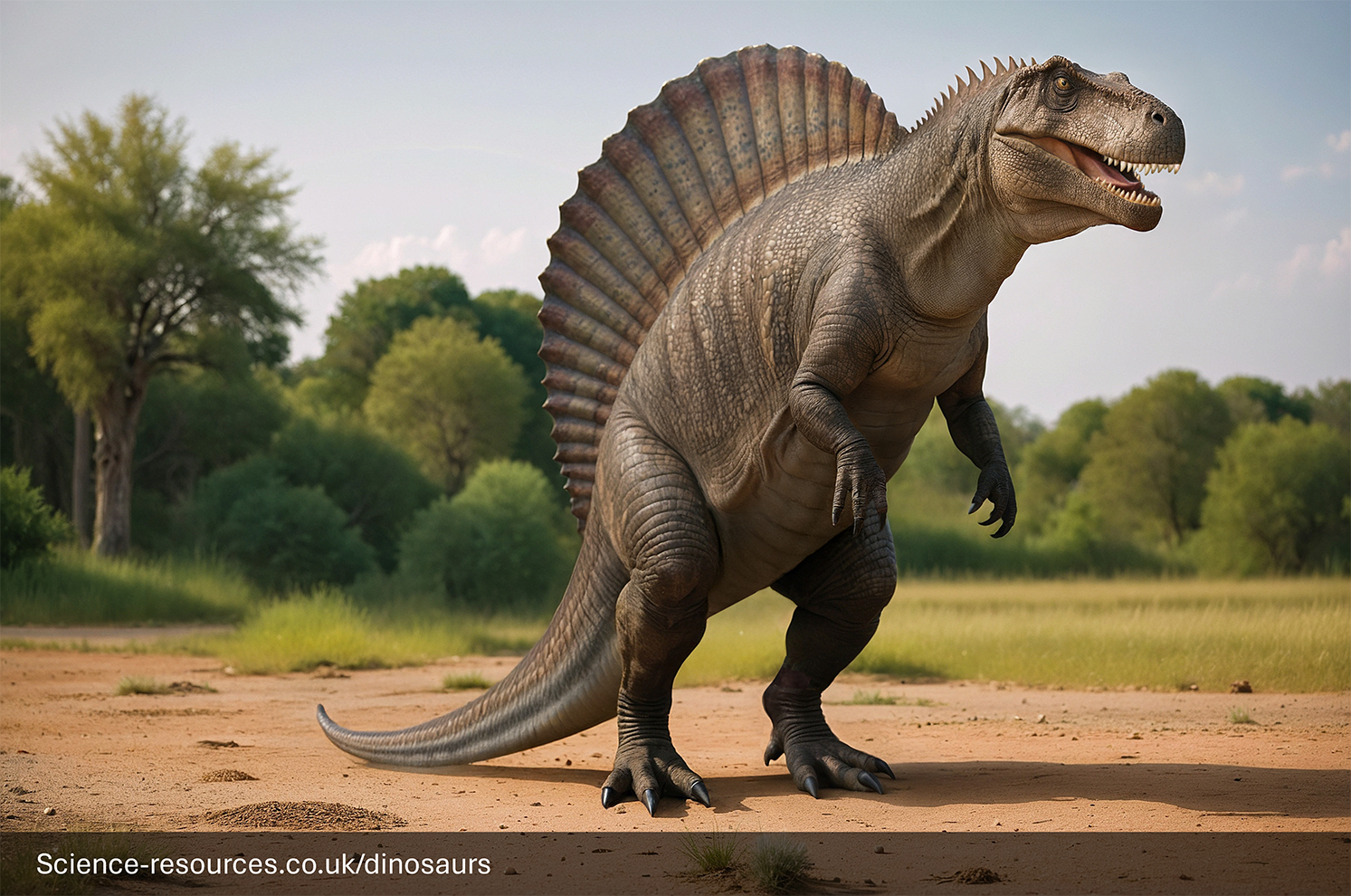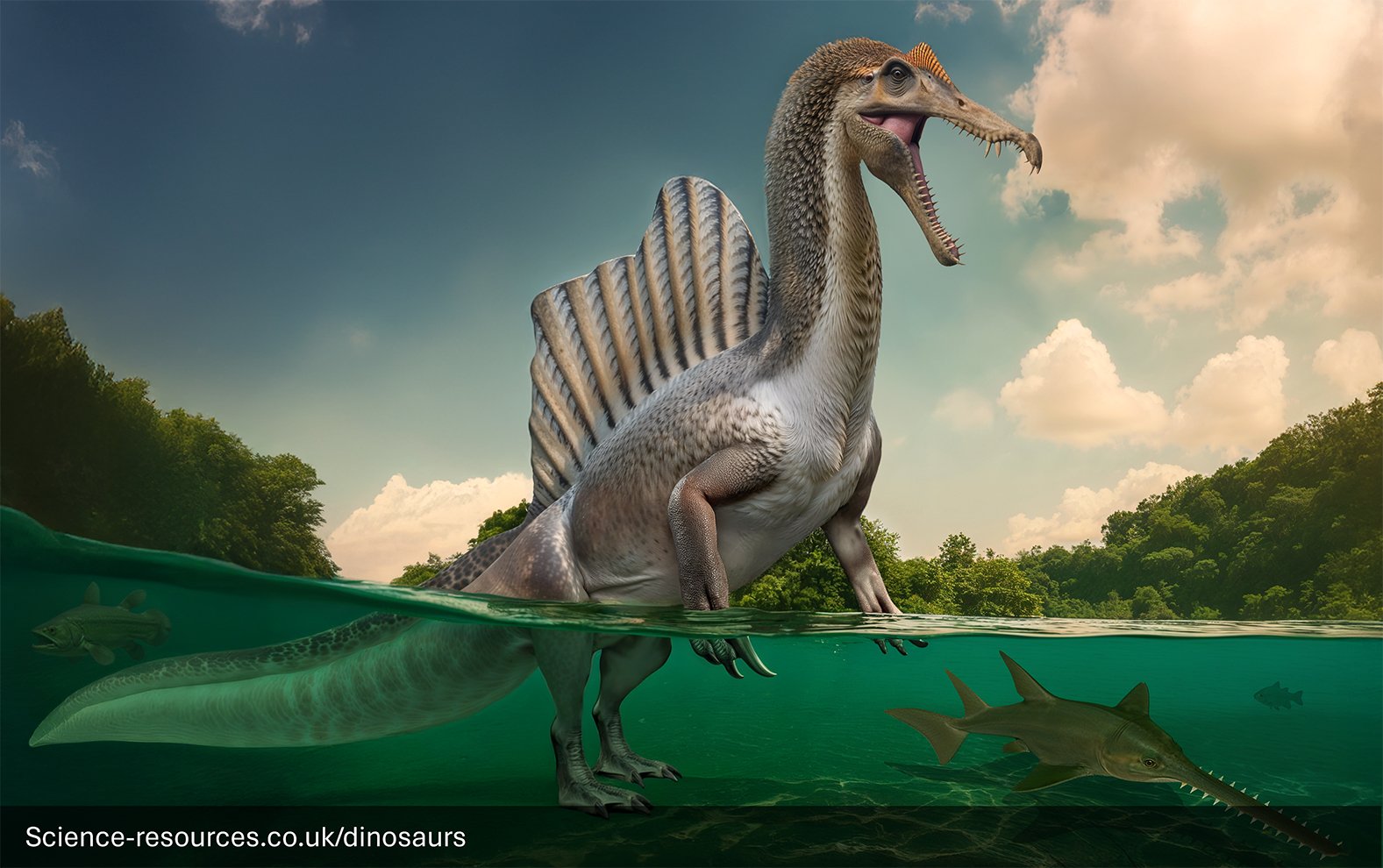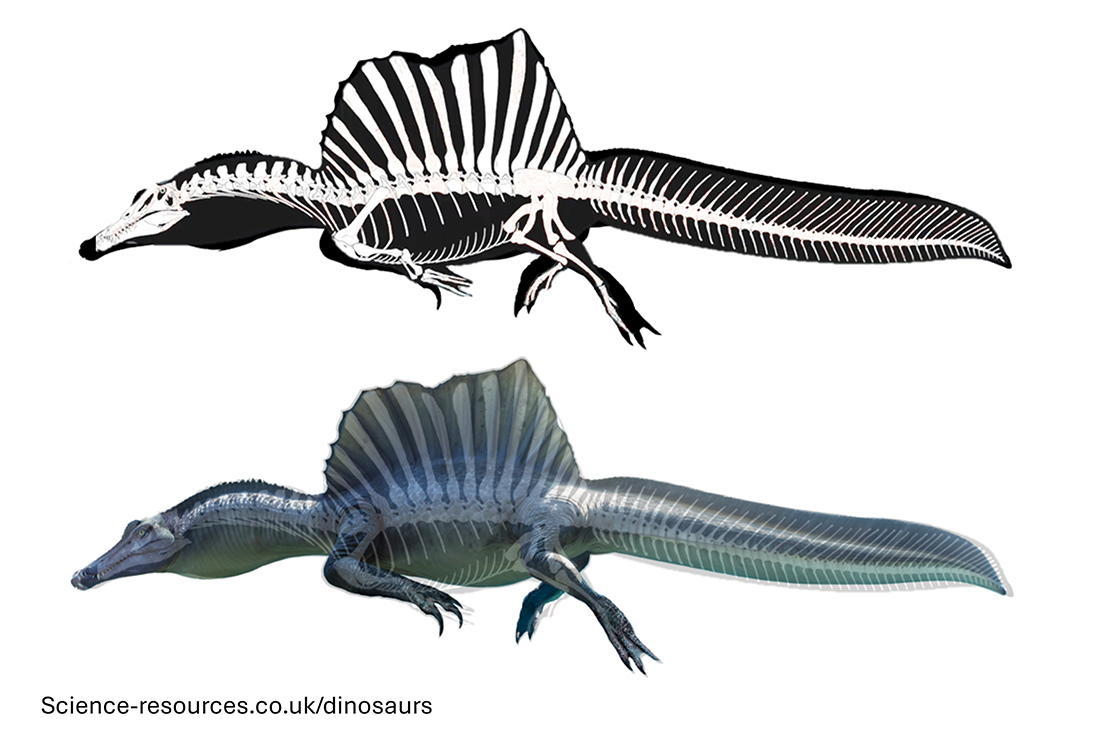Dinosaurs A:Z | S
You may also be intrested in: Free Dinosaur games
Dinosaurs: Spinosaurus (Spined Lizard)
You may also be intrested in: Free Dinosaur games
Last updated: 8th Feb 2025 Spinosaurus, whose name means "spine lizard," was a large, meat-eating dinosaur that lived during the Late Cretaceous period, around 99 to 94 million years ago. Spinosaurus is famous for its impressive sail-like structure on its back! Generative AI Notification: Some elements of this image have been created or enhanced using AI technology. To find out how we create all our dinosaurs, click here. Length: Spinosaurus could grow up to 14 meters (46 feet) long. Weight: This giant weighed around 7,400 kilograms (16,314 pounds). Spinosaurus had several unique and intriguing features: Teeth: It had smooth, cone-shaped teeth, perfect for catching fish. Sail: A tall sail on its back, possibly used for temperature regulation or mating displays. Legs: Short hind legs and possibly a wide, paddle-like tail. Snout: A long, narrow snout with a distinctive notch near the front, ideal for trapping fish. In the early 1900s, Spinosaurus was first described by German palaeontologist Ernst Stromer, based on fossils discovered in Egypt. In 1915, Stromer published his findings, portraying Spinosaurus as a large, bipedal theropod with a distinctive sail on its back. Due to the limited fossil material available at the time, it was reconstructed in a manner similar to other large theropods, such as Allosaurus and Tyrannosaurus, with an upright, kangaroo-like stance. From the mid-1900s to the early 2000s, scientists didn’t know much about Spinosaurus because they didn’t have many fossils to study. Without new evidence, they had to make educated guesses about what it looked like. Most drawings showed it as a large, heavy-built land-based predator, with a sail on its back. A major shift occurred in 2014, when new fossil discoveries from Morocco, led by Nizar Ibrahim, revealed several surprising features. These included shorter hind limbs, dense bones, and a long, paddle-like tail. These new findings suggested that Spinosaurus was not a typical land-dwelling predator, but rather a semi-aquatic animal adapted for life in and around water. As a result, scientific illustrations and popular media began to depict Spinosaurus as a more aquatic creature. Between 2020 and 2024, scientists found more fossils and did new studies to better understand how Spinosaurus lived and moved. Some scientists thought it was a strong swimmer, while others believed it mostly waded through shallow water to catch its prey. Drawings of Spinosaurus during this time showed it in different ways, some walking on two legs, others using its front limbs a bit like arms, but everyone agreed it was partly adapted for life in water and had a tall sail on its back. By 2025, scientists believe that Spinosaurus lived both in water and on land. It probably spent most of its time in rivers or swamps, using its long, crocodile-like snout and sharp, cone-shaped teeth to catch fish near the shore. New fossil studies show that it had a sleek body, strong bones in its legs, and a tall sail on its back. In modern drawings, Spinosaurus is usually shown with a flat, horizontal posture, either walking on two legs or using its front limbs to help support its body in certain situations. Spinosaurus was a carnivore, meaning it ate meat. It mainly fed on fish, including Onchopristis, thanks to its specialised jaws, but it may have also eaten other dinosaurs. Its long snout and sharp teeth made it an effective hunter in watery environments. Fossils of Spinosaurus have been found in North Africa, particularly in Egypt and Morocco. During the Late Cretaceous period, this area was made up of tidal flats and mangrove forests, providing an ideal habitat for a semi-aquatic lifestyle. • Meaning: Spinosaurus means "spine lizard." • Speed: Scientists believe it could walk on two legs, though some reconstructions show it walking on all fours. • Swimming: Spinosaurus may have spent a lot of its time in water, thanks to its paddle-like tail. • Sail Function: The sail could have been used for body temperature regulation, mating displays, or even helping it move through water. Spinosaurus was likely capable of walking on two legs, but scientists are still debating whether it might have also walked on all fours at times. Its short legs and long body suggest it could move efficiently in water. What is Spinosaurus?
 Walking with Dinosaurs: Semi-aquatic Spinosaurus (2025)
Walking with Dinosaurs: Semi-aquatic Spinosaurus (2025)How big was Spinosaurus
Appearance
How has our understanding of Spinosaurus' appearance changed over the years?
Early 1900s (1912–1944)
 Modern-day reimagining of Ernst Stromer's 1915 Spinosaurus skeleton reconstruction. (Dinosaur depicted as standing upright and dragging its tail - classic tripod stance).
Modern-day reimagining of Ernst Stromer's 1915 Spinosaurus skeleton reconstruction. (Dinosaur depicted as standing upright and dragging its tail - classic tripod stance). Mid-1900s to Early 2000s
 Mid-1900s to Early 2000s Spinosaurus
Mid-1900s to Early 2000s Spinosaurus2014–2020
 Aquatic Spinosaurus (2014-2020)
Aquatic Spinosaurus (2014-2020)2020–2024
 Semi-aquatic 2020-2024 Spinosaurus (Spinosaurus is depicted as wading through shallow water to catch its prey).
Semi-aquatic 2020-2024 Spinosaurus (Spinosaurus is depicted as wading through shallow water to catch its prey).2025 (Current understanding)
 Modern Spinosaurus (2025)
Modern Spinosaurus (2025)What did Spinosaurus eat?
Where did Spinosaurus live?
Interesting Facts
How did Spinosaurus move?
Pronounced: SPINE-oh-SORE-us Name Means: "Spined Lizard"


Spinosaurus Facts
Length: 14–18 metres (46–59 feet)
Weight: 12,000–20,000 kg (13–22 tons)
Diet: Carnivore (Meat)
Time: Late Cretaceous Period.
Habitat: Coastal Rivers
Fossils Found: Africa
There are several theories about the sail on Spinosaurus' back. It might have helped to regulate its body temperature, been used in mating displays to attract partners, or even assisted in swimming by acting as a stabilizer. While the evidence is limited, it's not confirmed that Spinosaurus had feathers, though it's possible. Spinosaurus is a theropod, and feathers evolved within that group. Some scientists theorise that Spinosaurus may have had some kind of plumage, possibly small, hair-like feathers. However, the lack of fossilised skin impressions makes it difficult to definitively say whether or not it had feathers. Spinosaurus had several unique features that set it apart from other dinosaurs: • Smooth teeth: Ideal for catching fish. • Powerful snout: Used to trap and catch prey. • Sail: A prominent feature that may have various uses. The portrayal of Spinosaurus in the Jurassic Park III movie has generated much debate. While the film's depiction was thrilling, modern research has provided a more nuanced understanding. For instance, Spinosaurus is now thought to have had a more aquatic lifestyle than shown in the movie, with adaptations for swimming and hunting in water. Spinosaurus (as depicted in the Jurassic park movie franchise) The most famous Spinosaurus fossil, discovered in Morocco (Stromer's original Egyptian finds were destroyed in WWII), has provided significant insights into its unique adaptations. New fossils and re-examinations of existing ones continue to refine our understanding of this incredible dinosaur. The discovery of a nearly complete tail in recent years dramatically changed perceptions of its locomotion and aquatic capabilities. Spinosaurus skeleton During the late Cretaceous Period, which spanned from approximately 100 to 66 million years ago, Spinosaurus shared its habitat with a multitude of other fascinating dinosaurs and prehistoric animals. Some of the notable contemporaries of T. Rex include:
Why did Spinosaurus have a sail?
Did Spinosaurus have feathers?
 A partially-feathered Spinosaurus
A partially-feathered SpinosaurusWhat were the unique features of Spinosaurus?
How accurate is the Jurassic Park Spinosaurus?

Fossil evidence

What other Dinosaurs / Prehistoric animals lived at the same time as Spinosaurus?
These diverse inhabitants of the late Cretaceous Period contributed to a vibrant and complex ecosystem, each playing unique roles in their environment.
Spinosaurus FAQ
Q1: What is a Spinosaurus?
A1: Spinosaurus was a large, carnivorous dinosaur that lived during the Cretaceous Period, around 112-93 million years ago. Its name means "spine lizard" because of the long spines on its back that formed a sail-like structure.
Q2: How big was the Spinosaurus?
A2: Spinosaurus was one of the largest carnivorous dinosaurs, growing up to 50 feet long and weighing around 7-20 tons. It had a long, narrow snout and a sail-like structure on its back.
Q3: What did Spinosaurus eat?
A3: Spinosaurus was primarily a piscivore, meaning it ate fish. Its conical teeth and long snout were well-suited for catching fish, but it may have also eaten other small animals.
Q4: Where did Spinosaurus live?
A4: Spinosaurus lived in what is now North Africa. Fossils have been found in Egypt, Morocco, and other parts of the Sahara Desert, which was a lush, riverine environment during the Cretaceous.
Q5: What makes Spinosaurus different from other dinosaurs?
A5: Spinosaurus is known for its distinctive sail-like structure on its back, which was formed by elongated spines. It also had a long, narrow snout and conical teeth, which were adaptations for catching fish.
Q6: How did Spinosaurus hunt its prey?
A6: Spinosaurus likely used its long snout and sharp teeth to catch fish in rivers and lakes. It may have also used its strong forelimbs and claws to grasp and hold onto its prey.
Q7: What did Spinosaurus look like?
A7: Spinosaurus had a long, narrow snout, a sail-like structure on its back, and strong forelimbs with large claws. Its body was covered in scales, and it had a long tail for balance.
Q8: Why is Spinosaurus important to scientists?
A8: Spinosaurus provides valuable insights into the evolution of spinosaurid dinosaurs and their adaptations for a semi-aquatic lifestyle. Its fossils help scientists understand the diversity of predatory dinosaurs during the Cretaceous.
Q9: Where can I see a Spinosaurus skeleton?
A9: You can see Spinosaurus skeletons in several museums, including the National Geographic Museum, where a reconstructed skeleton is on display.
Q10: What is the significance of the name Spinosaurus?
A10: The name Spinosaurus means "spine lizard," reflecting its distinctive sail-like structure formed by elongated spines on its back. It was named by paleontologist Ernst Stromer in 1915.